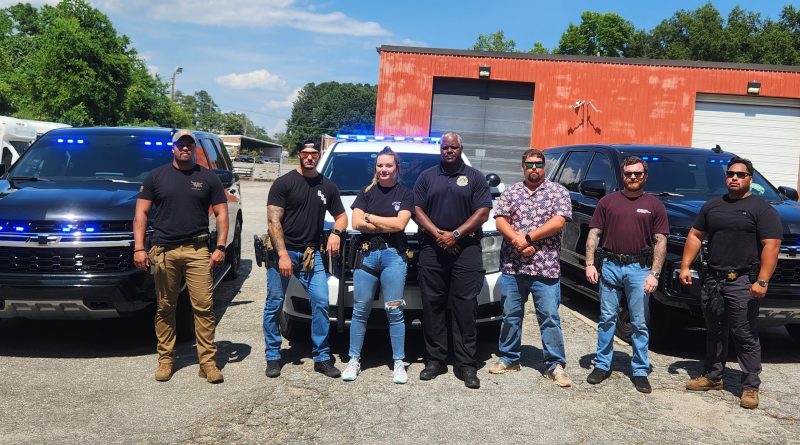Counter-gang sweeps across central South Carolina net scores of illegal weapons
Law enforcement agencies join forces under one roof to combat gangs and gang-related crimes in the Midlands of S.C.
By W. Thomas Smith Jr.
EDITOR’S NOTE: W. Thomas Smith Jr. has been participating in counter-gang operations with the Midlands Gang Task Force since, July 2. This story is based on his ground-zero experiences in those operations as well as his pre-operational and after-action briefings and one-on-one conversations with Task Force leaders. A version of this story appears in the Fall 2024 edition of THE SOUTHERN EDGE magazine.
In his book, THE VERY BEST MEN, author Evan Thomas discusses the early years of the Central Intelligence Agency. I’ve often thought of that book, one of my favorites, especially the declarative title and how it could be applied to so many other men (and women), organizations, and units. In fact, it’s an apt four-word description of an organization with which I have become intimately familiar over the past few years, particularly the last few weeks. I’m speaking of the multi-agency MIDLANDS GANG TASK FORCE (MGTF): Known in one of its previous iterations as the Midlands Gang and Fugitive Task Force.
Established in 2014 and jointly commanded by the Richland County Sheriff’s Department (RCSD) and the City of Columbia Police Department (CPD), the MGTF is a special law enforcement organization with a unique multifaceted mission of gathering intelligence on and disrupting-and-dismantling illegal gangs operating throughout the Midlands of South Carolina by means of combining single agency resources, expanding communication – through increased information and intelligence sharing – better productivity and a decrease in duplication of effort.
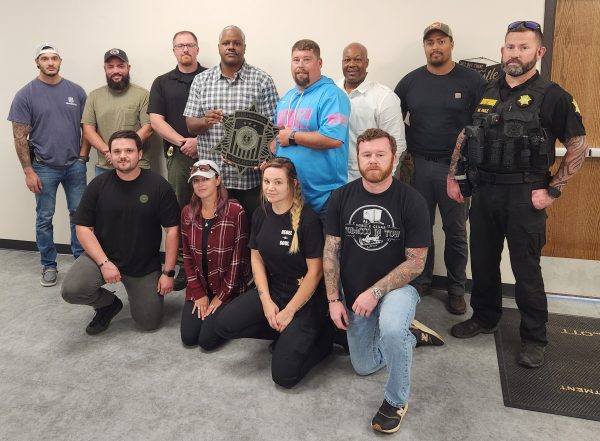
WORKING TOGETHER
In addition to its lead agencies RCSD and CPD, the MGTF is organized under a memorandum of understanding (MOU), which also includes the Irmo Police Department, the University of South Carolina Police Department, the Cayce Department of Public Safety (Police), the Forest Acres Police Department, the S.C. Department of Corrections (SCDC), the S.C. Department of Probation, Parole, and Pardon Services, the Benedict College Campus Police Department, the Alvin S. Glenn Detention Center, the Fifth Judicial Circuit Solicitor’s Office, the Columbia Housing Authority Police, and the U.S. Secret Service.
Non-MOU partners include the U.S. Drug Enforcement Administration (DEA); the Bureau of Alcohol, Tobacco, Firearms and Explosives (ATF); the Federal Bureau of Investigation (FBI); and the U.S. Marshal’s Office among others.
WHY ALL THE AGENCIES?
Everyone brings something complementary and unique to the table. And the MGTF is wholly unique in terms of how it operates. MGTF leaders see their overall mission and day-to-day work as fourfold: Narcotics (tactics and surveillance), investigations, patrol officer work (aka street cops), and education.
First, the MGTF operates similarly to the way in which any other narcotics unit would, and so the unit occasionally supports narcotics units and vice versa in combatting narcotics-trafficking and other narcotics related crimes.
The second component of the four is Investigations. Law enforcement officers within the MGTF are in practice, and some in both practice and title, investigators. They gather information from myriad sources to be processed into finished intelligence, they regularly conduct surveillance, and they actively investigate crimes.
Thirdly, MGTF members are regular patrol officers: Conducting crime-suppression operations and making traffic stops in high-crime areas.
Fourth and lastly is the educational component for schools, hospitals, civic organizations, and parks and recreation centers requesting such. As educators, MGTF leaders address specific gangs, activities unique to a given gang, gang dynamics, gang trends, and what to look for. In hospitals for instance, gunshot victims will often share information with physicians, nurses, and other medical professionals deemed informationally vital to the MGTF.
CURRENT OPERATIONS
In recent weeks, several counter-gang operations have been conducted across the Midlands of South Carolina with great success. Operations are ongoing (as of this writing) and forthcoming missions are in the intelligence-gathering and initial planning stages.
INDEPENDENCE WEEK OPERATIONS
On the afternoons of Monday, July 1, and Tuesday, July 2, MGTF leaders met at their north Columbia headquarters to discuss particulars of a raid to be conducted on a gang-affiliated residence deemed to be a trafficking hub for “za” juiced-up marijuana, illegal weapons, and who-knows-what-else. Developing intelligence through informants, known routine drug buys, and several forms of creative surveillance (for operational security we are not describing surveillance methods), the MGTF planned to launch the raid on July 2.
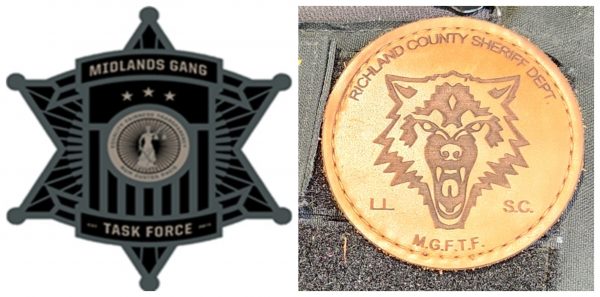
STORMING A GANG HOUSE
On the early evening of July 2, the MGTF waited until the primary suspect was identified and seen getting into his vehicle and leaving the residence. Several prepositioned marked and unmarked units (cars, SUVs, and a truck) waited as two separate units approached the primary target on the highway and away from the house. As soon as the target was pulled over, the pre-staged units swarmed the residence, surrounding the house on foot, announcing that they were “Police!” and battering-in the front door.
Storming the house and detaining two suspected gang-members (the third primary target already having been apprehended on the highway), the MGTF quickly seized several handguns, one with a gun “switch” (a tool in which gang members convert semi-automatic handguns into fully automatic press-the-trigger-and-spray weapons), three semi-automatic rifles, a trafficking amount of marijuana, two cash-counting machines, a $60,000 diamond necklace, and untold numbers of suitcases.
JULY 4TH CRIME SUPPRESSION
Two nights later, Thursday, July 4, MGTF leaders similarly met and briefed MGTF deputies and police officers, on what was essentially a crime-suppression mission, focusing on suspected gang-members and a few gang leaders gathered for an Independence Day party at an apartment complex wherein suspects were surveilled and tracked coming-and-going.
Marked and unmarked units then tracked and pulled-over suspect vehicles when necessary (traffic violations only). In one instance, a suspected gangmember attempted to run when he was “lit-up” with blue lights by MGTF units, but he was pursued, cut-off, and stopped by the SUV in which I was traveling.
Before the night was over, several arrests were made, a total of nine weapons seized, some crack cocaine, marijuana, open container violations, and in one instance one of the phones we seized began to ring with the unsuspecting caller being out on bond for murder. I was told by one of the MGTF officers: “Downloads will definitely come from that phone,” with numbers harvested for the processing of finished intelligence.
GANGS AND THE COUNTER-GANG UNIT
Point in all of this is that those who are apprehended are bad guys terrorizing the neighborhoods they live-in and roll-through, and they are actively recruiting newcomers many of whom are barely teenagers. Whereas sterling law enforcement officers and LE leaders like those I’ve recently been paired up with are as smart, tough, creative and tactically flexible as any deployed infantry soldiers and special operators in the U.S. Army and Marine Corps: Members of the MGTF have to be. And some of them actually did serve in Iraq or Afghanistan.
What also strikes me about these young men and women serving on the MGTF is that they are fair, kind, even familial in their interaction with apprehended suspects. Similar to how I remember American soldiers and Marines also treating suspected Al Queda affiliates and AQI members when I was in Iraq during the war.
A CULTURE OF SELFLESSNESS
Like soldiers and Marines serving overseas, these counter-gang operators are only as good as the man (or woman) on their left or their right, or the man coming behind them through a breached doorway, or in the vehicle behind them during a high-speed pursuit. They all embrace the Biblical mantra: “Here I am, send me.” All of them considering the other LE officer they are working shoulder-to-shoulder with as more important and worth protecting than themselves.
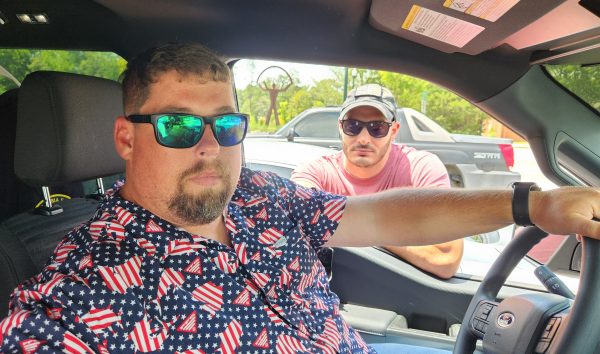
FRIDAY NIGHT “BLUE” LIGHTS AND SURVEILLANCE
The Friday night following the two Independence Week operations, specifically July 12, and into the wee hours of the 13th, I participated in yet another counter-gang operation with the MGTF. Unlike the previous week’s raid and a crime-suppression (interdiction) operation, the July 12-13 mission was primarily surveillance and intelligence gathering with a couple of blue-light pullovers and subsequent arrests for trafficking possession of marijuana. Cash and multiple firearms were also seized.
MONDAY MEETING AND A LITTLE-KNOWN PROBLEM
Every Monday the MGTF meets to discuss ongoing criminal cases, new intelligence gleaned, and how to proceed with forthcoming operations. On Monday, July 22, an officer with the SCDC also discussed the problem of and how to address illegal drone activity over the state’s prisons wherein gangs employ the use of drones (unmanned aerial vehicles) to smuggle contraband to inmates.
ADDITIONAL OPERATIONS
Friday July 26, the MGTF again met, this time, for a pre-launch briefing with some 18 MGTF members, then conducted what was billed in the briefing as a “divide and conquer operation” wherein MGTF units “hit” multiple high-crime locations and targets simultaneously within the city of Columbia and surrounding County regions. Before midnight, several arrests were made and several illegal weapons seized along with an undetermined amount of crack cocaine.
On the afternoon of Friday, August 2, I was again paired up with one of the MGTF leaders (a CPD Police sergeant who serves as MGTF deputy commander) and we conducted surveillance for a forthcoming date-to-be-determined countergang operation.
GUNS, DRUGS, AND RECRUITING
Human trafficking is a problem in central South Carolina, but that’s often worked by the MGTF’s federal partners like the FBI and the Department of Homeland Security according to MGTF officials.
Firearms proliferation and drug trafficking are currently the biggest challenges for the MGTF with the increasing popularity of the extremely dangerous drug, fentanyl. Gang recruitment is also becoming an expanding challenge with an increasing number of far-younger potential gang-members (primarily young males) being recruited online. In previous years, gang-members were recruited within a given neighborhood or a geographic region. Today, they are being heavily recruited through social media platforms like Instagram and Facebook which greatly expand the gangs’ reach.
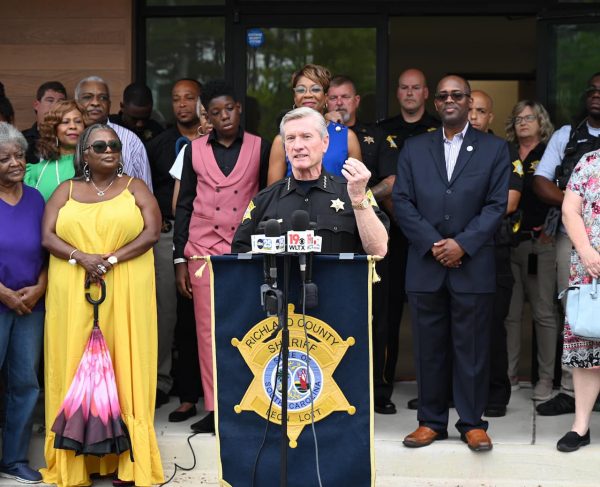
BIGGEST TAKEAWAY
Gangs are not going away any time soon. It’s a dangerously problematic cultural deviancy which law enforcement leaders and the men and women of the MGTF are always striving to address, and they are doing amazing work toward that end. Without sharing trade secrets, the MGTF is constantly developing new increasingly creative and clever methods of gathering intelligence on gangs, monitoring their activities, and means of directing young people from such. For obvious reasons we cannot get into the specifics of those methods and means, but it is the specifics that are, for me, the most encouraging takeaways in all of this.
(Featured image: Law enforcement officers with the multi-agency Midlands Gang Task Force are pictured in front of marked and unmarked vehicles prior to a July 4, 2024 countergang operation in Columbia and Richland County.)
– W. Thomas Smith Jr., a special deputy with the Richland County Sheriff’s Department, is a formerly deployed U.S. Marine infantry leader, a former SWAT team officer in the nuclear industry, a combat correspondent during the Iraq War, and a New York Times bestselling editor. Visit him online at http://uswriter.com.
